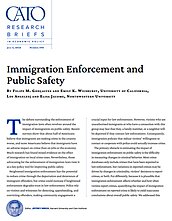The debate surrounding the enforcement of immigration laws often revolves around the impact of immigration on public safety. Recent surveys show that about half of Americans believe that immigrants are making crime in the country worse, and more Americans believe that immigrants have an adverse impact on crime than on jobs or the economy. Much research has found mixed evidence on the effect of immigration on local crime rates. Nevertheless, those advocating for the enforcement of immigration laws view it as a key policy tool for improving public safety.
Heightened immigration enforcement has the potential to reduce crime through the deportation and deterrence of immigrant offenders, but crime could increase if heightened enforcement degrades trust in law enforcement. Police rely on victims and witnesses for detecting, apprehending, and convicting offenders, making community engagement a crucial input for law enforcement. However, victims who are unauthorized immigrants or who have a connection with this group may fear that they, a family member, or a neighbor will be deported if they contact law enforcement. Consequently, immigration policies that reduce victims’ willingness to contact or cooperate with police could actually increase crime.
The primary obstacle to estimating the impact of immigration enforcement on public safety is the difficulty in measuring changes in criminal behavior. Most crime databases only include crimes that have been reported to law enforcement, but variations in reported crimes may be driven by changes in criminality, victims’ decisions to report crimes, or both. Put differently, because it is plausible that immigration enforcement affects whether and how often victims report crimes, quantifying the impact of immigration enforcement on reported crime is likely to yield inaccurate conclusions about overall public safety. We addressed this issue by using data from the National Crime Victimization Survey, which asks people whether they have been the victim of a crime and, if so, whether they reported that crime to the police. This survey allows us to separately estimate the impact of immigration enforcement on the incidence of crime and on crime reporting behavior. The survey includes the ethnicity of respondents, so we separately estimated the effects for Hispanic and non-Hispanic people. We focused on estimating the effects for Hispanic individuals—both citizens and noncitizens—because 90 percent of deported people are Hispanic and because prior research shows that heightened immigration enforcement has caused Hispanic citizens to reduce their participation in federal benefits programs due to fear that a family member or neighbor may be deported.
Our research studies the Secure Communities program, a federal policy that increased information sharing between local police and federal immigration authorities, thus streamlining the identification of unauthorized immigrants arrested by local police. This program was the largest expansion of interior immigration enforcement in US history and greatly increased immigrant detentions and deportations nationwide. Our analysis estimates that detentions by Immigration and Customs Enforcement increased by 54 percent following the program’s introduction. Importantly, authorities implemented the program piecemeal across counties between 2008 and 2013 due to resource constraints. We leveraged the differential timing of the program’s implementation to evaluate its impact on victimization and crime reporting.
Contrary to the policy’s goal of heightening enforcement to improve public safety, our analysis finds that this immigration enforcement policy increased the victimization rate of Hispanic people by 16 percent. This estimate implies that Secure Communities resulted in 1.3 million additional crimes against Hispanic people in the two years following the program’s implementation. An increase in property crimes (which comprise most victimizations) drives most of this effect, although our findings also provide suggestive evidence for an increase in violent crimes. Our research also finds no change in the overall victimization of non-Hispanic people. However, it finds an increase in the victimization of non-Hispanic people who live in areas with a high share of Hispanic residents. Across the full population (Hispanic and non-Hispanic people), we can rule out declines in total victimization of more than 3.3 percent.
Furthermore, our research finds that Secure Communities led to a significant decline in the rate of victims reporting crimes to the police. Hispanic people reduced their reporting rate by 30 percent. As with victimization, our results show no changes in the reporting behavior of non-Hispanic people.
The concurrent increase in victimization and decrease in victim reporting translate to a null impact on the number of crimes reported to the police after Secure Communities began. This result demonstrates the importance of separately measuring victimization and victim reporting to detect changes in public safety.
Our study provides novel evidence that the decline in reporting is the main driver of increased victimization. First, our results show that groups of counties with larger declines in reporting also experienced larger increases in victimization, indicating a clear link between these two outcomes. Second, our results show that the decline in reporting accounts for substantially more of the increase in victimization than the program’s effects on other factors that could impact crime—specifically, unemployment, wages, the share of female-headed households, and the male immigrant share of the population. These findings provide evidence that victim reporting is fundamental to maintaining public safety. Indeed, we studied a policy that was meant to reduce crime but instead increased it precisely because of its unintended impact on victim reporting. These findings thus highlight the trade-off between deterrence and community engagement in the design of immigration enforcement policies.
NOTE
This research brief is based on Felipe M. Gonçalves, Elisa Jácome, and Emily K. Weisburst, “Immigration Enforcement and Public Safety,” National Bureau of Economic Research Working Paper no. 32109, February 2024.

This work is licensed under a Creative Commons Attribution-NonCommercial-ShareAlike 4.0 International License.
